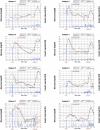Closed-loop artificial pancreas using subcutaneous glucose sensing and insulin delivery and a model predictive control algorithm: the Virginia experience
- PMID: 20144416
- PMCID: PMC2769907
- DOI: 10.1177/193229680900300506
Closed-loop artificial pancreas using subcutaneous glucose sensing and insulin delivery and a model predictive control algorithm: the Virginia experience
Abstract
Background: Recent progress in the development of clinically accurate continuous glucose monitors (CGMs), automated continuous insulin infusion pumps, and control algorithms for calculating insulin doses from CGM data have enabled the development of prototypes of subcutaneous closed-loop systems for controlling blood glucose (BG) levels in type 1 diabetes. The use of a new personalized model predictive control (MPC) algorithm to determine insulin doses to achieve and maintain BG levels between 70 and 140 mg/dl overnight and to control postprandial BG levels is presented.
Methods: Eight adults with type 1 diabetes were studied twice, once using their personal open-loop systems to control BG overnight and for 4 h following a standardized meal and once using a closed-loop system that utilizes the MPC algorithm to control BG overnight and for 4 h following a standardized meal. Average BG levels, percentage of time within BG target of 70-140 mg/dl, number of hypoglycemia episodes, and postprandial BG excursions during both study periods were compared.
Results: With closed-loop control, once BG levels achieved the target range (70-140 mg/dl), they remained within that range throughout the night in seven of the eight subjects. One subject developed a BG level of 65 mg/dl, which was signaled by the CGM trend analysis, and the MPC algorithm directed the discontinuance of the insulin infusion. The number of overnight hypoglycemic events was significantly reduced (p = .011) with closed-loop control. Postprandial BG excursions were similar during closed-loop and open-loop control.
Conclusion: Model predictive closed-loop control of BG levels can be achieved overnight and following a standardized breakfast meal. This "artificial pancreas" controls BG levels as effectively as patient-directed open-loop control following a morning meal but is significantly superior to open-loop control in preventing overnight hypoglycemia.
2009 Diabetes Technology Society.
Figures
Similar articles
-
Closed-loop artificial pancreas using subcutaneous glucose sensing and insulin delivery and a model predictive control algorithm: preliminary studies in Padova and Montpellier.J Diabetes Sci Technol. 2009 Sep 1;3(5):1014-21. doi: 10.1177/193229680900300504. J Diabetes Sci Technol. 2009. PMID: 20144414 Free PMC article.
-
Overnight closed-loop insulin delivery with model predictive control: assessment of hypoglycemia and hyperglycemia risk using simulation studies.J Diabetes Sci Technol. 2009 Sep 1;3(5):1109-20. doi: 10.1177/193229680900300514. J Diabetes Sci Technol. 2009. PMID: 20144424 Free PMC article.
-
Multinational study of subcutaneous model-predictive closed-loop control in type 1 diabetes mellitus: summary of the results.J Diabetes Sci Technol. 2010 Nov 1;4(6):1374-81. doi: 10.1177/193229681000400611. J Diabetes Sci Technol. 2010. PMID: 21129332 Free PMC article.
-
[What is the current state of the artificial pancreas in diabetes care?].Internist (Berl). 2020 Jan;61(1):102-109. doi: 10.1007/s00108-019-00713-y. Internist (Berl). 2020. PMID: 31863132 Review. German.
-
Diabetes technology and treatments in the paediatric age group.Int J Clin Pract Suppl. 2011 Feb;(170):76-82. doi: 10.1111/j.1742-1241.2010.02582.x. Int J Clin Pract Suppl. 2011. PMID: 21323816 Review.
Cited by
-
Closed-loop insulin delivery: update on the state of the field and emerging technologies.Expert Rev Med Devices. 2022 Nov;19(11):859-875. doi: 10.1080/17434440.2022.2142556. Epub 2022 Nov 4. Expert Rev Med Devices. 2022. PMID: 36331211 Free PMC article. Review.
-
Meal Detection in Patients With Type 1 Diabetes: A New Module for the Multivariable Adaptive Artificial Pancreas Control System.IEEE J Biomed Health Inform. 2016 Jan;20(1):47-54. doi: 10.1109/JBHI.2015.2446413. Epub 2015 Jun 16. IEEE J Biomed Health Inform. 2016. PMID: 26087510 Free PMC article.
-
Progress in development of an artificial pancreas.J Diabetes Sci Technol. 2009 Sep 1;3(5):1002-4. doi: 10.1177/193229680900300502. J Diabetes Sci Technol. 2009. PMID: 20144412 Free PMC article.
-
Pilot study of a prototype minimally invasive intradermal continuous glucose monitor.J Diabetes Sci Technol. 2012 Nov 1;6(6):1454-63. doi: 10.1177/193229681200600627. J Diabetes Sci Technol. 2012. PMID: 23294793 Free PMC article. Clinical Trial.
-
The artificial pancreas: is it important to understand how the β cell controls blood glucose?J Diabetes Sci Technol. 2013 Sep 1;7(5):1359-69. doi: 10.1177/193229681300700528. J Diabetes Sci Technol. 2013. PMID: 24124965 Free PMC article. Review.
References
-
- Santiago JV, Clemens AH, Clarke WL, Kipnis DM. Closed-loop and open-loop devices for blood glucose control in normal and diabetic subjects. Diabetes. 1979;28(1):71–84. - PubMed
-
- Clemens AH, Chang PH, Myers RW. The development of Biostator, a glucose controlled insulin infusion system (GCIIS) Horm Metab Res. 1977;(Suppl 7):23–33. - PubMed
-
- Clarke WL, Kovatchev B. The artificial pancreas: how close are we to closing the loop? Pediatr Endocrinol Rev. 2007;4(4):314–316. - PubMed
-
- Steil GM, Rebrin K, Darwin C, Hariri F, Saad MF. Feasibility of automating insulin delivery for the treatment of type 1 diabetes. Diabetes. 2006;55(12):3344–3350. - PubMed
-
- Weinzimer SA, Steil GM, Swan KL, Dziura J, Kurtz N, Tamborlane WV. Fully automated closed-loop insulin delivery versus semiautomated hybrid control in pediatric patients with type 1 diabetes using an artificial pancreas. Diabetes Care. 2008;31(5):934–939. - PubMed
Publication types
MeSH terms
Substances
Grants and funding
LinkOut - more resources
Full Text Sources
Other Literature Sources
Medical


